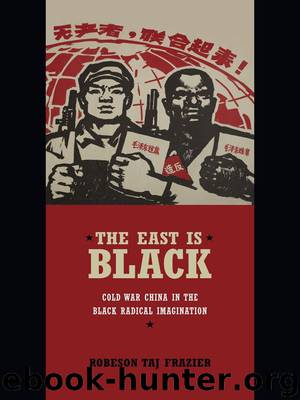The East Is Black: Cold War China in the Black Radical Imagination by Robeson Taj Frazier

Author:Robeson Taj Frazier [Frazier, Robeson Taj]
Language: eng
Format: epub
ISBN: 9780822376095
Publisher: Duke University Press
Published: 2014-12-02T23:00:00+00:00
“The Orientation of the Youth Movement” (Qingnian yundong de fangxiang) a speech that Mao delivered to Chinese youths in Yan’an in 1939, was one of the first works Garvin read that offered her helpful themes around which to organize both her class lectures and the overall instructional culture of her classes. In the speech Mao appropriated the May Fourth Movement, demonstrations led by Chinese students in opposition to the Treaty of Versailles in 1919, as a model for the anti-imperialist work required of Chinese youths. Mao explained that class struggle and transition toward communism could only be instigated by “learning the theory of revolution and studying the principles and methods for resisting,” and then physically transforming the nation by taking “part in labor,” which denoted the ability to unify ideological thinking with political practice.34 Unpacking the speech’s thesis, Garvin wrote: “In his article, ‘The Orientation of the Youth Movement,’ Chairman Mao described a revolutionary youth as one who is both willing to integrate himself with the broad masses of workers and peasants, and [who] does so in practice.”35 Garvin thus ruled that of supreme import would be that her students consider the politics of their future pedagogy. They would have to dedicate serious time and energy to mulling over the relationship between their teaching and language practice and the daily struggles faced by Chinese people. This meant that class discussions and readings had to be pragmatic—high theory had to be made applicable to material conditions. It also meant continuously reevaluating ideas and methods so that both she and students could learn from mistakes and turn past errors and failures into lessons and achievements.
Another idea that Garvin found fruitful was what Mao described in 1952 as gu wei jin yong, to “make the past serve the present.”36 Garvin similarly decided that critical engagement of history would play a major function in her class. Students would be compelled to put historical analysis in conversation with the roles they would play in contemporary class struggle, national development, and world relations. The second half of Mao’s dictum, yang wei zhong yong, meaning to make “the foreign serve China,” became another feature of Garvin’s teaching philosophy. Mao’s tribute to the Canadian surgeon Norman Bethune, for instance, informed Garvin’s understanding of how she, as a non-Chinese educator, could aid Chinese teachers and students in advancing China toward communism. Mao’s 1939 essay “In Memory of Norman Bethune” (jinian Bai Qiuen) memorialized Bethune’s service to China during the country’s war of resistance against Japanese imperialism, and the essay encouraged foreigners sympathetic to China to follow Bethune’s example.37 Garvin perceived teaching in similar terms, identifying her classroom as a site for the evolution of her internationalist praxis. Introducing herself to the institute’s university body, she laid out this realization: “As we attempt to integrate ourselves into the life and work of the Institute, our experience will be two-sided: receiving as well as giving, learning as well as teaching, thereby enriching our theories with practice. We look forward to a
Download
This site does not store any files on its server. We only index and link to content provided by other sites. Please contact the content providers to delete copyright contents if any and email us, we'll remove relevant links or contents immediately.
| Anthropology | Archaeology |
| Philosophy | Politics & Government |
| Social Sciences | Sociology |
| Women's Studies |
Cecilia; Or, Memoirs of an Heiress — Volume 1 by Fanny Burney(32404)
Cecilia; Or, Memoirs of an Heiress — Volume 3 by Fanny Burney(31803)
Cecilia; Or, Memoirs of an Heiress — Volume 2 by Fanny Burney(31775)
The Great Music City by Andrea Baker(31240)
We're Going to Need More Wine by Gabrielle Union(18939)
All the Missing Girls by Megan Miranda(15467)
Pimp by Iceberg Slim(14292)
Bombshells: Glamour Girls of a Lifetime by Sullivan Steve(13946)
Talking to Strangers by Malcolm Gladwell(13173)
Norse Mythology by Gaiman Neil(13161)
Fifty Shades Freed by E L James(13141)
For the Love of Europe by Rick Steves(12549)
Mindhunter: Inside the FBI's Elite Serial Crime Unit by John E. Douglas & Mark Olshaker(9146)
Crazy Rich Asians by Kevin Kwan(9144)
The Lost Art of Listening by Michael P. Nichols(7380)
Enlightenment Now: The Case for Reason, Science, Humanism, and Progress by Steven Pinker(7141)
The Four Agreements by Don Miguel Ruiz(6580)
Bad Blood by John Carreyrou(6513)
Weapons of Math Destruction by Cathy O'Neil(6110)
